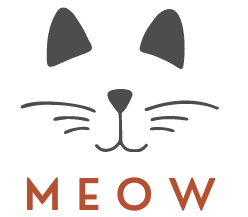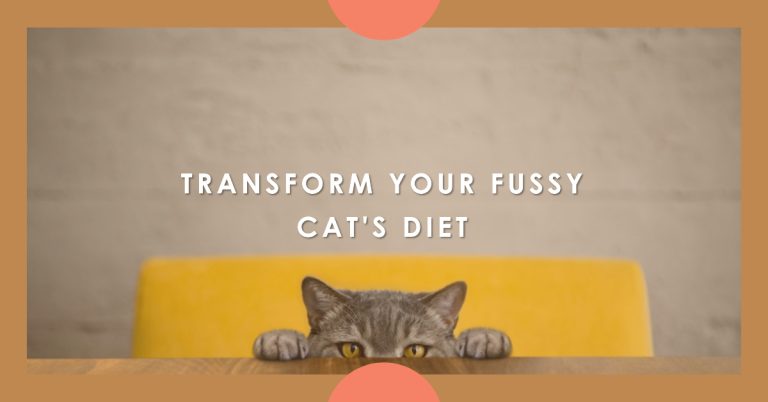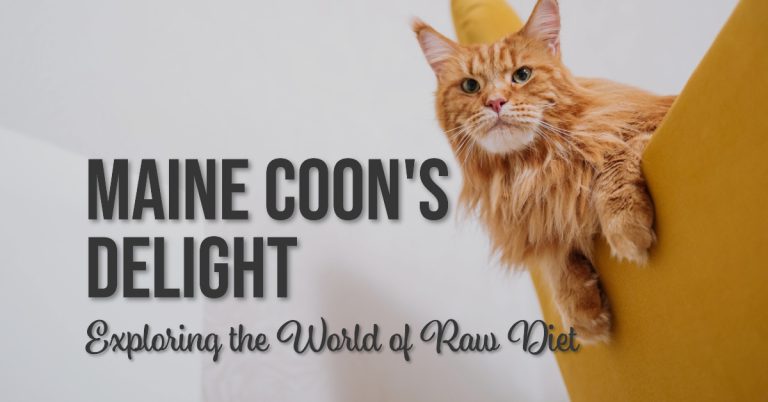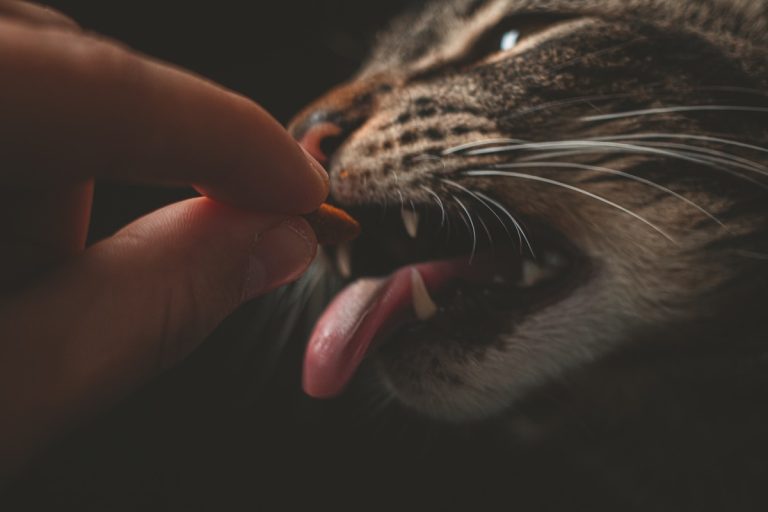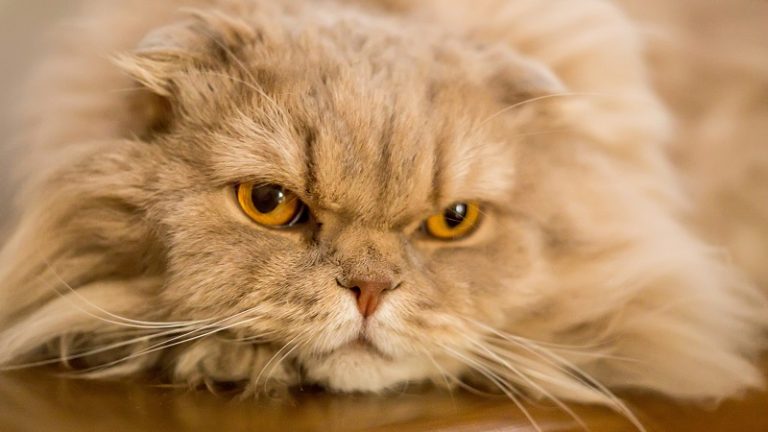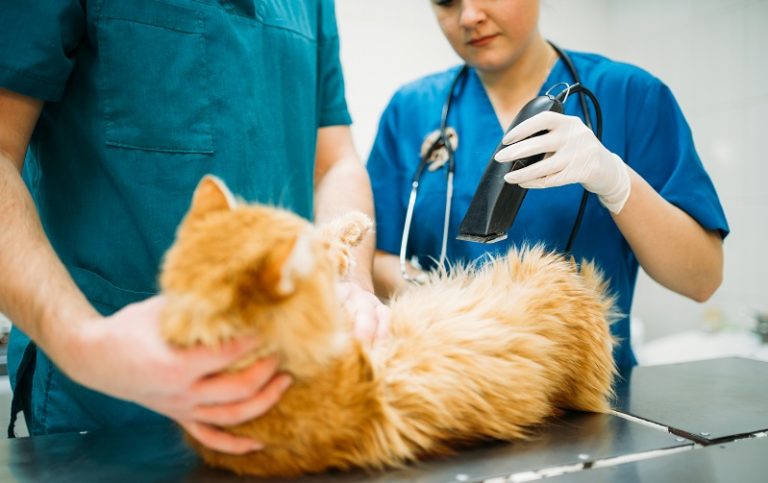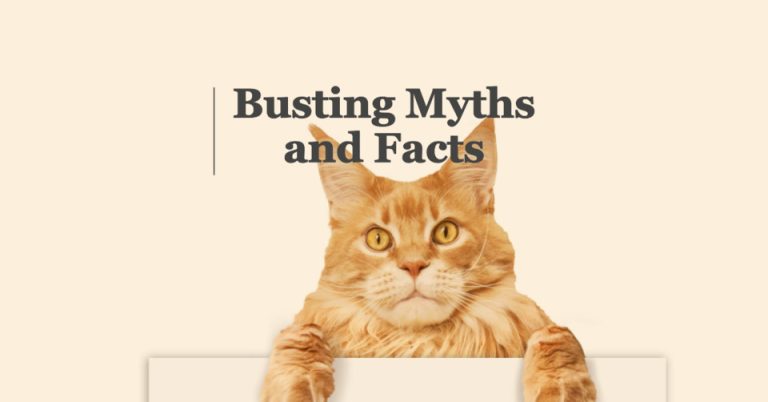The Purr-fect Transition: Shifting Your Maine Coon to Raw Food
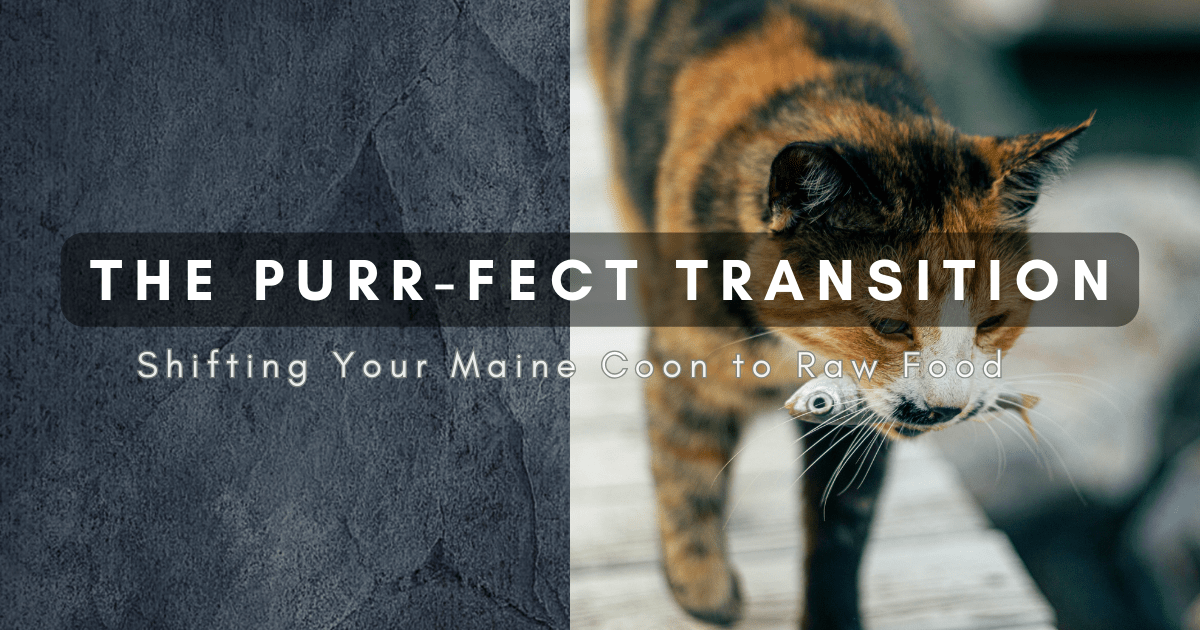
Chapter 01: Introduction
A. Transitioning from Processed Food to a Raw Diet
Transitioning your Maine Coon from processed cat food to a raw diet is a significant step towards ensuring their long-term health and well-being. While many cat owners may be content with the convenience of commercial cat food, it’s essential to recognize the potential benefits of a raw food diet for your feline friend. In this chapter, we will explore the reasons behind this transition, the advantages it offers, and the importance of a gradual shift.
Why Transition to Raw Food?
Maine Coon cats, known for their large size and playful nature, require a diet that supports their unique nutritional needs. Raw food offers a plethora of benefits, primarily because it closely mimics what a cat would eat in the wild. Here are a few compelling reasons to make the switch:
- Nutritional Superiority: Raw food is rich in essential nutrients, such as protein, vitamins, and minerals, which are vital for your Maine Coon’s growth and overall health.
- Improved Digestion: Cats’ digestive systems are designed to handle raw meat, making it easier for them to absorb nutrients from this natural diet.
- Healthy Coat and Skin: A raw diet can lead to a shinier coat and healthier skin due to the high-quality proteins and fats it contains.
- Dental Health: Chewing on raw bones and meat can help maintain your cat’s dental hygiene by reducing the risk of dental problems.
- Weight Management: Raw diets often result in better weight management, reducing the likelihood of obesity in your Maine Coon.
The Importance of a Gradual Transition
Switching your Maine Coon to a raw diet isn’t something that should be done abruptly. Cats can be quite particular about their food, and a sudden change can lead to digestive upset or refusal to eat altogether. That’s why a gradual transition is essential.
Throughout this guide, we will provide you with valuable tips and insights on how to make this transition as smooth as possible, whether you’re starting with a kitten or an older cat. Each cat is unique, and their journey towards a raw diet may vary, but with patience and persistence, you can make this transition successfully.
In the following chapters, we will delve deeper into the specifics of transitioning kittens, older cats, and the gradual process of shifting from both wet and dry cat food to a raw diet. Remember, the well-being of your Maine Coon is at the heart of this transition, and by the end of this guide, you’ll be equipped with the knowledge and tools to provide them with a healthier and more natural diet.
Read our article about 7 Tasty Maine Coon Raw Food Recipes You Must Try
Chapter 02: Transitioning Kittens
A. Starting Early with Kittens
When it comes to transitioning kittens to a raw food diet, starting early is key to establishing healthy eating habits from the beginning of their lives. Kittens are more adaptable and open to new food experiences than older cats, making the transition smoother. In this section, we’ll discuss the importance of beginning the raw food journey during their early stages of development.
1. Kittens’ Rapid Growth and Nutritional Needs: Kittens undergo rapid growth and development in their first few months of life. Their nutritional requirements are significantly different from those of adult cats. Raw food can provide the high-quality protein, vitamins, and minerals needed to support their growth and overall health.
2. Developing a Taste for Raw Food: By introducing raw food to kittens early, you help them develop a preference for this natural diet. Kittens are more likely to accept new foods during their formative weeks, making it easier to establish a lifelong raw food feeding routine.
3. Gradual Introduction: Even though kittens are generally more receptive to dietary changes, it’s still essential to introduce raw food gradually. Start by mixing a small portion of raw food with their current kitten formula. As they become accustomed to the taste and texture, you can increase the proportion of raw food in their diet.
B. Feeding Frequency and Quantities for Kittens
Kittens have specific feeding requirements regarding both frequency and portion sizes. To ensure they receive the right balance of nutrients during the transition to a raw food diet, consider the following guidelines:
1. Frequent Meals: Kittens have small stomachs and high energy levels. Offer them multiple small meals throughout the day to keep their energy levels stable and support their growth. Aim for at least four to five feedings a day.
2. Portion Sizes: The portion size for kittens will vary depending on their age, weight, and activity level. Typically, a guideline is to feed them about 2-3% of their body weight per meal. However, consult with your veterinarian to determine the exact portion sizes tailored to your kitten’s specific needs.
3. Monitoring Growth: Regularly monitor your kitten’s weight and adjust their food portions accordingly. Kittens should steadily gain weight, but not too rapidly, as excessive weight gain can lead to health issues.
C. Ensuring a Smooth Transition from the Beginning
A smooth transition to a raw food diet for kittens requires patience and consistency. Here are some tips to help ensure a successful shift from their current diet:
1. Gradual Increase: As mentioned earlier, gradually increase the proportion of raw food in their meals over a period of several weeks. Monitor their acceptance and adjust the transition pace as needed.
2. Mixing with Kitten Formula: Continue to mix the raw food with their current kitten formula as you increase the raw food percentage. This helps them get accustomed to the new flavors and textures while maintaining their nutritional intake.
3. Variety: Offer a variety of raw meat sources to expose kittens to different flavors and textures. This can help prevent them from becoming too finicky about their food.
By starting early, addressing their specific feeding needs, and maintaining a patient and gradual transition, you can set your kittens on a path towards a lifelong, healthy raw food diet. In the following sections, we’ll explore additional aspects of transitioning kittens to ensure their successful adaptation to this natural and nutritious way of eating.
Chapter 03: Transitioning Older Cats
A. Emphasizing Patience in Transitioning Older Cats
Transitioning older cats to a raw food diet requires a different approach compared to kittens or younger cats. Older cats may have well-established dietary preferences and habits, making the transition more challenging. Patience is paramount during this process. Let’s explore why patience is essential and how to navigate this transition successfully:
1. Respect Their Comfort Zone: Older cats have likely been eating a specific diet for most of their lives. Abrupt changes can lead to resistance or digestive issues. Recognize that it may take longer for them to adapt to a new diet.
2. Gradual Transition: Transitioning should be a gradual process, allowing older cats to adjust at their own pace. Start by mixing a small amount of raw food with their current diet and slowly increase the raw food portion over several weeks.
3. Observe Their Response: Pay close attention to your cat’s reactions. Some may be more willing to try raw food sooner than others. Respect their cues and don’t force the change too quickly.
B. Importance of Gradually Introducing New Textures and Smells
Older cats may be particularly sensitive to changes in texture and smell, as they have likely grown accustomed to the characteristics of their current food. Here’s why it’s crucial to introduce new textures and smells gradually:
1. Texture Transition: Begin by offering raw food with textures similar to what they are used to. For example, if your cat prefers wet canned food, choose finely ground or minced raw food. As they become comfortable, you can gradually introduce coarser textures.
2. Gradual Flavor Shift: Mix the raw food with their current diet to create a blend of familiar and new flavors. Over time, you can increase the proportion of raw food while decreasing their previous diet.
3. Warming the Food: Cats often prefer their food at room temperature. Slightly warming the raw food can enhance its aroma and make it more appealing to older cats.
C. Tips for Enticing Older Cats to Try Raw Food
Transitioning older cats to a raw food diet can be challenging, but there are several strategies you can employ to make the process smoother and more enticing:
1. Experiment with Protein Sources: Offer a variety of protein sources, such as chicken, turkey, or fish, to cater to their taste preferences.
2. Add Supplements: Consider adding supplements like taurine or omega-3 fatty acids to ensure their nutritional needs are met during the transition.
3. Use Food Puzzles: Food puzzles or interactive feeders can engage older cats’ natural hunting instincts and make mealtime more stimulating.
4. Patience and Positive Reinforcement: Be patient and use positive reinforcement, such as praise and treats, to reward them for trying the new food.
5. Consult Your Veterinarian: Always consult with your veterinarian before making significant dietary changes for older cats. They can provide valuable guidance and monitor your cat’s health throughout the transition.
Remember that each older cat is unique, and the transition timeline may vary. Some may adapt quickly, while others may take several months. The key is to be patient, adaptable, and attentive to your cat’s needs and preferences. With time and persistence, many older cats can successfully transition to a raw food diet, reaping the health benefits it offers in their later years.
Chapter 04: Essential Rules for Successful Transition
A. Addressing the Importance of Smell in Cat Food
Cats have a highly developed sense of smell, which plays a crucial role in their food preferences. When transitioning your Maine Coon to a raw food diet, understanding the significance of smell can make the process smoother. Here’s why it matters and how you can use it to your advantage:
1. Smell and Palatability: The aroma of food greatly influences a cat’s willingness to eat it. Cats are more likely to be attracted to foods with strong, appealing scents. Raw food, being fresh and unprocessed, often has a more potent natural odor that can entice cats.
2. Familiarity with Smells: Cats are creatures of habit, and they become accustomed to the smell of their current diet. When introducing raw food, it might have a different scent that your cat is not familiar with, leading to initial hesitation.
3. Gradual Introduction: To address this, gradually introduce the smell of raw food by mixing it with their current diet. Over time, they will become more accustomed to the new scent and be more accepting of the raw food.
B. Creative Ways to Mask the Smell of Raw Food
While the smell of raw food can be attractive to some cats, others may find it unfamiliar or off-putting. Here are creative ways to help mask or modify the smell of raw food to make it more appealing:
1. Aromatic Herbs: Sprinkle a pinch of cat-safe herbs like catnip or parsley over the raw food to introduce pleasant aromas and flavors.
2. Bone Broth Soaking: Soak the raw food briefly in bone broth or warm water to soften the scent and add moisture, making it more appealing.
3. Food Toppers: Consider using cat food toppers that are designed to enhance the flavor of your cat’s meal. These often have enticing aromas that can make the raw food more attractive.
4. Slow Transition: As mentioned earlier, gradually introduce raw food alongside their current diet. This not only helps with the smell but also allows your cat to adjust to the new flavors over time.
C. Behavioral Tips for Serving Raw Food to Cats
Cats can have unique behaviors and preferences when it comes to mealtime. To successfully serve raw food to your Maine Coon, consider these behavioral tips:
1. Establish Routine: Cats thrive on routine. Try to feed your cat at the same times each day to create a predictable schedule.
2. Serve at Room Temperature: Cats often prefer food that is closer to their body temperature. Let the raw food come to room temperature before serving it to enhance its aroma and appeal.
3. Calm Feeding Environment: Ensure a quiet and stress-free feeding environment. Cats may be more willing to try new foods when they feel safe and relaxed.
4. Patience and Persistence: Some cats may be hesitant initially. Be patient and persistent, and avoid scolding or forcing your cat to eat the raw food. Allow them to explore it at their own pace.
5. Monitor Hydration: Raw food diets can be lower in moisture compared to wet cat food. Ensure your cat stays adequately hydrated by providing fresh water.
By understanding the importance of smell in cat food, employing creative ways to make raw food more appealing, and considering your cat’s behavior during mealtime, you can navigate the transition to a raw diet more effectively. Each cat is unique, so don’t be discouraged if it takes time for your Maine Coon to fully embrace this healthier way of eating. With patience and a bit of ingenuity, you can help your cat enjoy the benefits of a raw food diet.
Chapter 05: Transitioning from Wet Food
A. Step-by-Step Guide for Transitioning from Wet Food to Raw
Transitioning your Maine Coon from wet food to a raw diet can be a rewarding journey for both you and your cat. However, it’s essential to take it one step at a time to ensure a smooth and successful transition. Here’s a step-by-step guide to help you navigate this process:
Step 1: Preparation
- Gather all the necessary supplies, including high-quality raw cat food, bowls, and utensils.
- Consult your veterinarian to ensure your cat is healthy and suitable for a raw diet.
Step 2: Gradual Introduction
- Start by mixing a small portion of raw food with your cat’s wet food. Use a ratio of approximately 10% raw food to 90% wet food in the beginning.
- Ensure the mixture is well-blended to make it appealing and consistent in texture.
Step 3: Observe and Adjust
- Monitor your cat’s reaction to the new mixture. Look for signs of acceptance, such as eagerness to eat or positive body language.
- Gradually increase the proportion of raw food over the course of several days or weeks. Aim to reach a 50-50 ratio of raw food to wet food.
Step 4: Full Transition
- Once your cat is comfortable with a 50-50 mix, start decreasing the wet food and increasing the raw food in each meal.
- Continue this process until your cat is consuming 100% raw food.
Step 5: Maintain Consistency
- Once your cat has fully transitioned to a raw diet, maintain consistency in their meals. Stick to a regular feeding schedule and monitor their health and well-being.
B. Gradual Increase of Raw Food Percentage
Gradually increasing the percentage of raw food in your cat’s diet is crucial to a successful transition. Here’s why and how to do it:
1. Minimizing Digestive Upset: Cats’ digestive systems need time to adapt to new foods. A slow increase in raw food helps minimize digestive upset and allows their bodies to acclimate.
2. Behavioral Adjustment: Cats can be creatures of habit. Slowly increasing the raw food percentage helps them adjust both physically and mentally to the new diet.
3. Reducing Refusal: Cats may refuse to eat if the transition is too abrupt. Gradually increasing the raw food percentage makes the change less noticeable.
4. Mixing and Monitoring: As mentioned in the step-by-step guide, regularly mix a higher percentage of raw food into each meal, watching for your cat’s acceptance and comfort level. Be flexible and adapt the pace according to their responses.
C. Ensuring a Complete Switch to Raw Food
A complete switch to raw food is the ultimate goal of the transition. Here are some tips to help ensure a successful and lasting switch:
1. Gradual Progress: The transition process may take several weeks or even months, depending on your cat’s individual preferences and comfort level. Be patient and let your cat set the pace.
2. Offer Variety: Introduce a variety of raw meat sources to keep your cat interested and ensure they receive a well-rounded diet.
3. Monitor Health: Regularly check your cat’s weight, coat condition, and overall health during the transition. If you notice any concerns, consult with your veterinarian.
4. Stick to a Routine: Cats thrive on routine. Maintain a consistent feeding schedule to help them adjust to their new diet more easily.
5. Positive Reinforcement: Use positive reinforcement, such as praise and affection, when your cat shows enthusiasm for raw food. This can help reinforce their preference for the new diet.
Transitioning from wet food to a raw diet is a gradual process that requires patience and flexibility. By following these steps and paying close attention to your cat’s needs and reactions, you can ensure a successful switch and provide your Maine Coon with the health benefits of a raw food diet.
Chapter 06: Transitioning from Dry Food
A. Transitioning from a Dry Food Diet
Transitioning your Maine Coon from a dry food diet to a raw diet requires careful planning and patience. Dry food is often high in carbohydrates and lacks the moisture content essential for feline health. Here’s a step-by-step guide to help you make the switch:
Step 1: Evaluation
- Assess your cat’s overall health and consult with your veterinarian to ensure they are suitable for a raw food diet.
- Understand the reasons for transitioning, including the health benefits associated with a raw diet.
Step 2: Gradual Introduction
- Start by introducing a small amount of raw food alongside your cat’s dry food. Begin with a ratio of about 10% raw food to 90% dry food.
- Mix the two foods thoroughly to create a blend that combines familiar and new flavors.
Step 3: Observe and Adjust
- Monitor your cat’s response to the mixture. Look for signs of interest and acceptance.
- Gradually increase the proportion of raw food while reducing the dry food. Aim for a 50-50 ratio over time.
Step 4: Reducing Dry Food
- Continue decreasing the dry food portion and increasing the raw food percentage in each meal.
- Be patient and attentive to your cat’s comfort level and adjust the transition pace accordingly.
Step 5: Full Transition
- Once your cat is comfortably consuming a 50-50 mix, begin reducing the dry food even further while increasing the raw food portion.
- Continue this process until your cat is exclusively on a raw food diet.
B. Keeping Dry Food Available During the Transition
During the transition from dry food to raw, it’s essential to keep dry food available to ensure your cat’s nutritional needs are met and to avoid any sudden dietary changes that could lead to digestive upset. Here’s how to manage dry food availability:
1. Balanced Diet: Dry food can act as a safety net to ensure your cat receives essential nutrients during the transition. Choose a high-quality dry food that complements the raw diet.
2. Separate Feeding Stations: Set up separate feeding stations for dry food and raw food. This prevents contamination and allows your cat to choose their preference at each meal.
3. Limited Access: Control access to dry food by offering it at specific times of the day. This helps prevent your cat from solely relying on dry food and encourages them to explore the raw diet.
4. Monitor Consumption: Keep an eye on how much dry food your cat consumes and adjust the portion size accordingly to ensure they continue to make progress in the transition.
C. Gradually Increasing Raw Food and Reducing Dry Food
The key to a successful transition from dry food to raw is gradual progress. Here are some tips to help you increase the raw food percentage while reducing dry food:
1. Incremental Changes: Increase the raw food portion by 10% increments while decreasing the dry food portion over several days or weeks.
2. Monitor Behavior: Watch your cat’s behavior and appetite during this transition. They should show increased interest in the raw food as the ratio shifts in favor of raw.
3. Consult Your Veterinarian: Regularly consult with your veterinarian throughout the transition to ensure your cat’s health and nutritional needs are being met.
4. Be Patient: Some cats may take longer to fully transition than others. Be patient and adjust the pace based on your cat’s comfort level and preferences.
5. Offer Variety: Introduce a variety of raw meat sources to keep meals interesting and to ensure a well-rounded diet.
Transitioning from a dry food diet to a raw diet requires persistence and careful management. By following these steps and paying close attention to your cat’s needs and reactions, you can successfully make the switch and provide your Maine Coon with a healthier and more natural diet.
Chapter 07: Transitioning to PurrForm Raw
A. Steps for Switching to PurrForm Raw Food
Transitioning to PurrForm raw food can be a beneficial choice for your Maine Coon. PurrForm offers a high-quality raw food option designed to meet your cat’s nutritional needs. Here are the steps to make a successful switch to PurrForm raw food:
Step 1: Research PurrForm Raw Food
- Familiarize yourself with the PurrForm product line and their various raw food options. Understanding the available flavors and formulations will help you choose the best fit for your cat.
Step 2: Consult Your Veterinarian
- Before starting the transition, consult with your veterinarian to ensure that PurrForm raw food is a suitable choice for your cat’s specific health needs.
Step 3: Introduction
- Begin by introducing a small amount of PurrForm raw food alongside your cat’s current diet. Use a ratio of about 10% PurrForm raw to 90% of their current food.
Step 4: Observe and Adjust
- Pay close attention to your cat’s response to the new food. Look for signs of acceptance and monitor their digestive health.
- Gradually increase the proportion of PurrForm raw food while decreasing their current diet. Aim for a 50-50 ratio over time.
Step 5: Full Transition
- Once your cat is comfortably consuming a 50-50 mix, begin reducing their current diet while increasing the PurrForm raw food portion.
- Continue this process until your cat is exclusively on a PurrForm raw food diet.
B. Gradual Increase of PurrForm Raw Food Percentage
A gradual increase in the percentage of PurrForm raw food is essential for a successful transition. Here’s why and how to do it:
1. Minimizing Digestive Upset: Slowly increasing the raw food portion allows your cat’s digestive system to adapt, reducing the risk of digestive issues during the transition.
2. Behavioral Adjustment: Cats often prefer familiar foods. Gradual changes give your cat time to adjust to the new flavors and textures of PurrForm raw food.
3. Reducing Refusal: Cats can be sensitive to dietary changes. Gradually increasing the PurrForm raw food portion helps prevent refusal or reluctance to eat.
4. Monitoring: Continuously monitor your cat’s comfort level, appetite, and overall well-being during the transition. Be flexible and adapt the pace to their individual preferences.
C. Completing the Transition to PurrForm Raw
Completing the transition to PurrForm raw food is the ultimate goal. Here’s how to ensure a successful switch:
1. Consistency: Once your cat is exclusively on PurrForm raw food, maintain consistency in their meals. Stick to a regular feeding schedule and monitor their health.
2. Variety: Consider rotating between different PurrForm flavors and formulations to provide your Maine Coon with a diverse and balanced diet.
3. Veterinary Check-Ups: Continue regular check-ups with your veterinarian to ensure your cat’s health and nutritional needs are met.
4. Patience and Persistence: The transition process may take time, and each cat is unique. Be patient and persistent, and always prioritize your cat’s well-being.
Chapter 08: Key Points to Remember
A. Emphasizing Patience in the Transition Process
- Patience is vital throughout the transition to any raw food diet. Cats may take varying amounts of time to adapt to new foods, so allow them to set the pace.
B. Mixing Current Diet with Raw Food
- Mixing current food with raw food helps ease the transition. Gradually shift the balance to raw food over time.
C. Providing a Variety of Raw Food Flavors
- Offer a variety of raw food flavors to keep mealtime interesting and provide a well-rounded diet.
D. Serving Food at Room Temperature
- Cats generally prefer food served at room temperature. Warming up raw food slightly can enhance its aroma and appeal.
E. Establishing a Feeding Routine
- Cats thrive on routine. Establish a consistent feeding schedule to help your cat adjust to their new diet more easily.
By following these steps and key points, you can ensure a smooth and successful transition to PurrForm raw food, providing your Maine Coon with a nutritious and satisfying diet that supports their health and well-being.
Chapter 09: Feeding Guidelines
A. Daily Feeding Amount Based on Body Weight
Determining the daily feeding amount of raw food for your Maine Coon based on their body weight is crucial to provide the right balance of nutrients. Here’s a general guideline:
- Adult Cats: Feed approximately 2-3% of your cat’s body weight per day. For example, if your cat weighs 10 pounds (4.5 kg), feed them 3.2 to 4.5 ounces (90-128 grams) of raw food daily.
- Kittens: Kittens may require more, around 5-7% of their body weight per day, as they are still growing rapidly.
B. Adjusting Portions Based on Appetite
Cats’ appetites can vary from day to day. To adjust portions based on appetite:
- Offer the recommended daily amount in multiple small meals throughout the day.
- Pay attention to your cat’s cues. If they consistently leave uneaten food, consider reducing the portion size slightly.
- If your cat is consistently hungry and finishes their meals quickly, you can gradually increase the portion size.
C. Managing Uneaten Food
Managing uneaten food is important to maintain freshness and hygiene:
- Remove uneaten raw food after 20-30 minutes to prevent spoilage or bacterial growth.
- Store uneaten food in the refrigerator for a short time, but avoid leaving it out at room temperature for extended periods.
- Discard any uneaten food that has been left out for too long to ensure your cat’s safety.
D. Handling Frozen Raw Food Safely
When handling frozen raw food, follow these safety guidelines:
- Thaw frozen raw food in the refrigerator to prevent the growth of harmful bacteria. This process may take several hours or overnight.
- Use separate utensils and bowls for raw food to prevent cross-contamination with other foods.
- Wash your hands and surfaces thoroughly after handling raw food to avoid the spread of bacteria.
- Do not refreeze raw food once it has been thawed; use it within a few days.
Chapter 10: Conclusion
In conclusion, transitioning your Maine Coon to a raw diet offers numerous benefits, including improved nutrition, healthier coat and skin, and better weight management. However, it’s crucial to emphasize the importance of a gradual transition to ensure your cat’s comfort and well-being throughout the process.
By following the feeding guidelines, adjusting portions based on appetite, managing uneaten food responsibly, and handling frozen raw food safely, you can provide your cat with a balanced and nutritious diet that supports their overall health.
Remember that each cat is unique, and the transition may take time. Be patient, consult with your veterinarian for guidance, and prioritize your cat’s health and happiness throughout this journey.
FAQs
- Can I transition my cat to a raw diet suddenly?
- It’s best to transition gradually to prevent digestive upset.
- How can I tell if my cat is ready for a full raw diet?
- Monitor their acceptance and comfort with increasing raw food proportions.
- Should I mix different raw food flavors?
- Yes, offering variety can make meals more enjoyable and nutritionally balanced.
- What’s the ideal food temperature for serving raw food?
- Room temperature is preferred by most cats.
- How often should I feed my cat on a raw diet?
- Multiple small meals throughout the day are ideal for cats.
- Can I adjust portion sizes based on my cat’s weight?
- Yes, daily feeding amounts should be based on your cat’s body weight.
- What should I do if my cat doesn’t finish their raw food?
- Remove uneaten food after 20-30 minutes to maintain freshness.
- Is it safe to leave raw food out for my cat all day?
- It’s not recommended; raw food can spoil quickly.
- Can I refreeze raw food once it’s been thawed?
- No, it’s best to use thawed raw food within a few days.
- Why is a gradual transition to a raw diet important?
- It allows your cat’s digestive system to adapt and prevents dietary shock.
